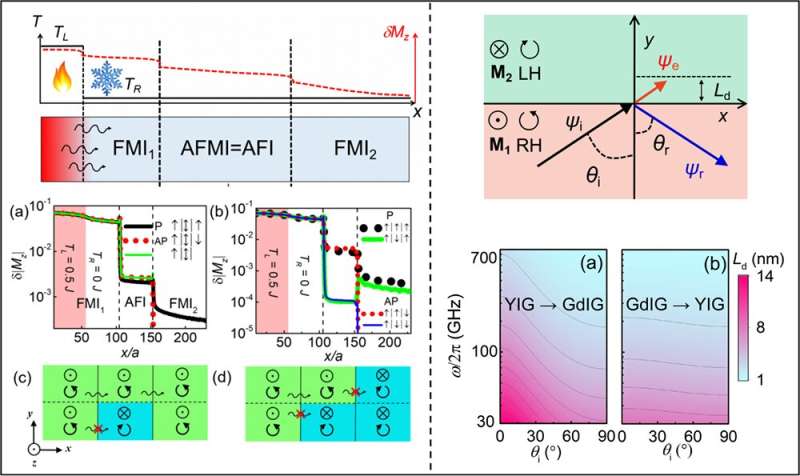Magnon blocking effect and magnonic skin effect shown in antiferromagnetically coupled heterojunction

Spin waves, or magnons, as the elementary excitation of the magnetic system, can transfer spin angular momentum, which provides wide prospects for the Non-volatile, low-energy-consumption, high-speed and small-size microelectronic devices in the post-Moore period. Magnonics, encompassing the generation, transport and manipulation of magnons, has become the latest development direction of spintronics and an emerging discipline of condensed matter physics.
In recent years, Prof. HAN Xiufeng's research group at the Institute of Physics of the Chinese Academy of Sciences (CAS) has developed a magnon valve with a core structure of magnetic insulator (MI)/spacer(S)/magnetic insulator (MI) (such as YIG/Au/YIG), a magnon junction (such as YIG/NiO/YIG) and a magneto electric separator which can be used as magnon generator and magnon detector (such as Pt/YIG/Pt), aiming to use pure electrical methods and the change of the magnetic structures to effectively control the generation and transport of magnons, thus to realize a 100% transmission switch on-off ratio of the magnon currents.
Therefore, a further in-depth understanding of the transport properties of incoherent or coherent magnons in a completely electrically insulated magnon junction will become the key physical basis for the development of practical magnonic devices and circuits in the future.
In order to better understand the mechanism of magnon transmission in magnon junction from the microscale, PHD student YAN Zhengren, Associate Professor WAN Caihua, and Prof. HAN Xiufeng studied the magnon transmission in the sandwich structure of ferromagnetic insulator (FMI)/antiferromagnetic insulator (AFI)/ferromagnetic insulators (FMI) by atomistic spin-model simulations.
They found that magnon junction effect (MJE) or magnon valve effect (MVE) can be reproduced, demonstrating the magnetization-dependent magnon transmission. The MJE and MVE are stemmed from the polarization of spin wave.
In general, spin-up (spin-down) lattices can only accommodate right- (left-) handed circularly polarized magnons. While only right-handed circularly polarized magnons are favored in FMI with upward magnetization, both left- and right-handed circular polarizations are permitted in AFI owing to two spin-opposite lattices. This selection rule thus makes the total reflection of spin wave occur when magnons try to diffuse into a spin lattice, which does not support their polarization.
For instance, when right-handed circular magnons excited in spin-up region are injected into the spin-down region, the selection rule would result in low magnon transmission across the interface. This phenomenon called magnon blocking effect, which shows that the spin-wave polarization plays an important role in magnon transmission.
Furthermore, they theoretically studied the scattering behavior of spin waves at the interface of an antiferromagnetically coupled heterojunction. It is shown that the spin-waves passing through the interface are evanescent waves and the incident waves are all reflected back, demonstrating a magnetization-dependent magnon blocking effect in this structure.
The result indicates that with the increase of the spin-wave frequency, the decay length decreases and the evanescent wave are more concentrated at the interface, showing a magnonic skin effect which is similar to the skin effect of electromagnetic waves.
Furthermore, a positive magnonic Goos-Hänchen shift of the reflected waves was also predicted. It can be understood by an effective reflection interface shift induced by the nonzero decay length of the evanescent waves.
In summary, the results show that the efficient manipulation of coherent/incoherent magnons by magnon junctions stems from the inherent chirality of magnons in magnetic materials. These discoveries confirm the physical basis of magnon devices to efficiently manipulate magnon transport, and provides a new development direction and technical route for the development of pure magnon-type storage and logic devices.
This research was published in Phys. Rev. B.
More information: Z. R. Yan et al, Magnonic skin effect and magnon valve effect in an antiferromagnetically coupled heterojunction, Physical Review B (2021). DOI: 10.1103/PhysRevB.104.L020413
Journal information: Physical Review B
Provided by Chinese Academy of Sciences





















